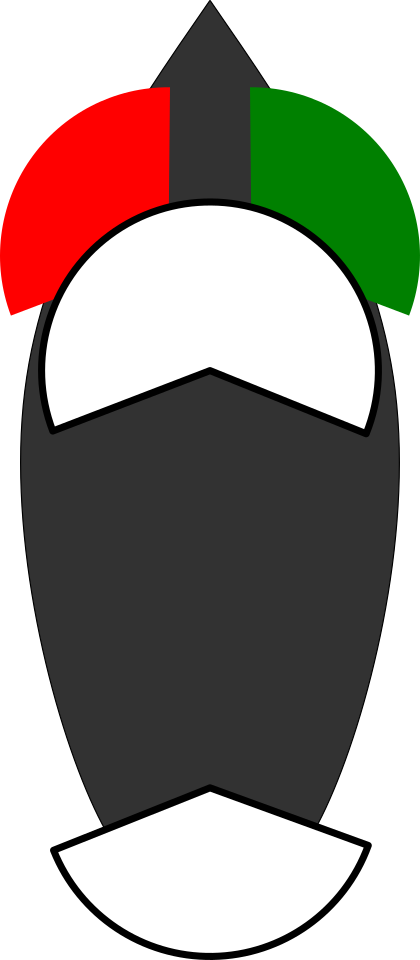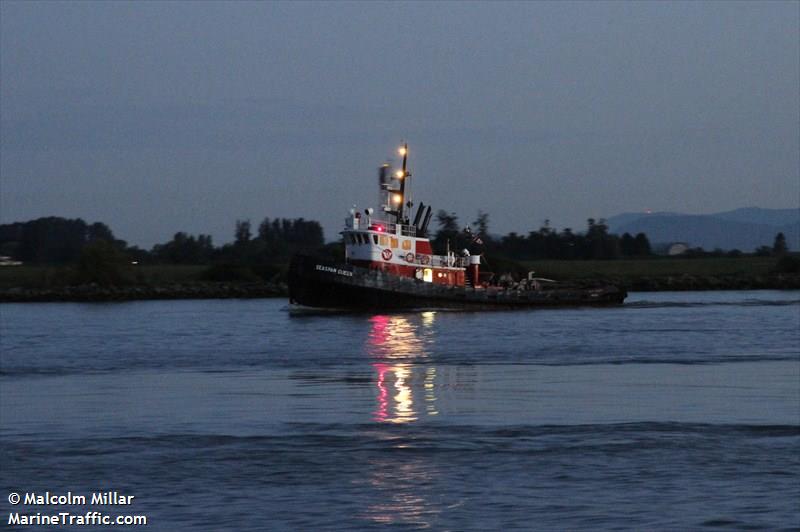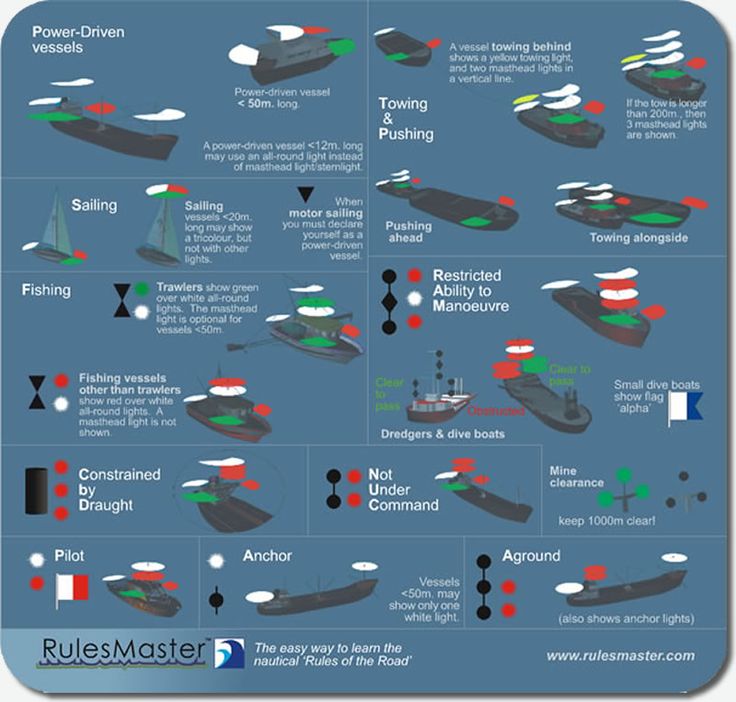COLREGS Part C Lights
 Vessels are required to show appropriate lights from sunset to sunrise and at other times when it seems appropriate, but particularly during restricted visibility. No other lights are to be shown unless they cannot be mistaken for the lights specified in the COLREGS.
Vessels are required to show appropriate lights from sunset to sunrise and at other times when it seems appropriate, but particularly during restricted visibility. No other lights are to be shown unless they cannot be mistaken for the lights specified in the COLREGS.
The coverage by sidelights, masthead lights, and stern lights is shown in the diagram.
The basic lights are sidelights (red for the port side and green for the starboard side) and a stern light (white). The sidelights cover from ahead to 22.5 degrees abaft the beam on each side. Each sidelight covers 112.5 degrees. The stern light covers 135 degrees across the stern.
Sailing Vessels
Vessels that are sailing and not under power may simply exhibit side lights and a stern light.
In addition to sidelights and a stern light, a sailing vessel may show two vertical all-round lights high on the mast, red over green.
A sailing vessel under 20m may use a lantern at or near the top of the mast combining three lights: red and green sidelights and white stern light. But, if so, the vessel should not show the red-green all-round lights for a sailing vessel.
A small sailing vessel (under 7m) may use a single white light to show its presence. This may be shined on the sail to help with detection.
The diagram below (from RulesMaster) does not show the red-over-green all-round light combination nor does it show the single white light that can be used by a small sailboat.
A sailboat if using an engine for propulsion is considered a power-driven vessel and should show the masthead light for that. She should not show the lights for a sailing vessel.
Vessel Under Oars and Similar Vessels
The COLREGS specify that a vessel under oars may show the lights for a sailing vessel. If she does not do this, she must have ready a white light that can be shown to avoid collision.
Operators of other human-powered vessels -- kayaks, canoes, dragon boats, wind-surfers -- should also carry a white light that can be used to avoid collision, although these other types are not specifically mentioned in the COLREGS.
Power-driven Vessels
A power-driven vessel when underway shall exhibit sidelights and a stern light. In addition she will show a masthead light (white) forward (white), and a second masthead light abaft and higher than the first masthead light.
A smaller power-driven (under 50 metres) is not required to show the second masthead light (but may show the second masthead light). The diagram shows the light pattern for a smaller power-driven vessel. An even smaller power-driven vessel (under 12 metres) may use a combined all-round white light as a substitute for a masthead light and stern light combination. (Note that our vessels use this provision to have a single all round white light instead of a masthead light and a stern light. This does cause some minor issues, e.g., if one of our vessels is being towed it should not show a masthead light forward and should show only sidelights and a stern light.)
An air cushion vessel (hovercraft) when riding above the surface shall exhibit an all round flashing yellow light in addition to the appropriate lights for a power-driven vessel. The Canadian Coast Guard operates hovercraft from the base at Sea Island, near Vancouver airport.
A wing-in-ground-effect platform will show high intensity all-round flashing red light when on or near the water surface. None are operating in B.C. waters as far as we know.
Submarines are not specifically mentioned in COLREGS. However the Royal Canadian Navy has a procedure that its submarines when operating on the surface with show a flashing yellow light (90 flashes per minute). This is in addition to appropriate lights for a power-driven vessel. The United States Navy has a different procedure for its submarines. It will show an intermittent flashing amber beacon with a sequence of operation of one flash per second for three (3) seconds followed by a three (3) second off-period. In addition the submarine will show the lights for a power-driven vessel. Canadian and American submarines on the surface may be encountered near Esquimalt, Nanoose Bay, and in area WHISKEY GULF (a military training area between Nanoose Bay and Sechelt).
Vessels that are Towing or Pushing
 A vessel that is towing or pushing will show the sidelights and stern light for a power-driven vessel. It will show two or three vertical masthead lights, instead of the single masthead light for the usual power-driven vessels. Two masthead lights will be shown if the tow does not exceed 200m and three if it is does. The towing vessel will also show a towing light at the stern above the stern light; a towing light covers the same sector as a stern light, but is the light is yellow.
A vessel that is towing or pushing will show the sidelights and stern light for a power-driven vessel. It will show two or three vertical masthead lights, instead of the single masthead light for the usual power-driven vessels. Two masthead lights will be shown if the tow does not exceed 200m and three if it is does. The towing vessel will also show a towing light at the stern above the stern light; a towing light covers the same sector as a stern light, but is the light is yellow.
If a pushing vessel and a vessel being pushed are rigidly connected they should be treated as single power-driven vessel and will not use any special lights.
A power-driven vessel if pushing (not in a composite unit) or towing alongside it will show light for towing: two or three vertical masthead lights and a towing light. If it is of appropriate size it will show another masthead light abaft and above the two or three vertical lights.
A vessel being pushed or towed will show sidelights and a stern light. It should not show a masthead light as that would indicate that it is under (its own) power. Most power-driven vessels that RCM SAR would have to tow in local waters with have an white all-round light instead of a separate masthead and stern light; thus it will be unable to show only a stern light. A sailing vessel should be able to show sidelights and a stern light (and nothing resembling a masthead light) as those are the lights it would normally show when sailing.
Log booms are frequently seen under tow in B.C. waters. They should be lit as partly submerged objects. If the tow is less than 25m in breadth it should have a white all-round light forward and another aft. If it is 25m or more in breadth it should also have a white light at the portside extremity and another white light at the starboard extremity. If the tow is more than 100m long it should have more white lights in between so the distance between white lights is not more than 100m. All of these white lights should be all-round lights.
When a towed vessel or object cannot show appropriate lights, they should show lights that indicate to others vessels that a tow in progress. If a towing vessel cannot make the normal lights for towing, it should use what it can to indicate the relationship between it and the tow. One measure is to have a spotlight on the tow line so other vessel will exercise appropriate caution.
Canadian modifications to the COLREGS require barge to have a white all-round light fore and aft. A group of barges in the same tow may have a white all-round light at the front of the ground and one at the end. If the group is more than 100m long, then there should be another white all-round light at the midpoint of the group. There are also relaxed provisions for a log boom: essentially white all-round lights to mark the extremities of the boom.
Vessels Engaged in Fishing
Vessels that are engaged in fishing, but not trawling, show two all-round lights, red over white. If they are trawling they show two all-round lights that are green over white. They will show these even if they are not making way. If they are making way, they will also show side lights and a stern light. A trawling vessel may show a masthead light higher than the green-white combination, abaft of those lights and higher. If a trawling vessel is 50m long or longer it must display this masthead light; if less than 50m long, it is not obliged to show this masthead light.
A vessel engaged in fishing, but not trawling, that has gear that extends more 150m will also be showing a white all-round light in the direction of the gear.
A vessel is not engaged in fishing shall not use the lighting for a vessel engaged in fishing. A vessel that is engaged in fishing but is not underway or is at anchor will show the appropriate all-round lights associated with fishing.

Other Classes of Vessel
Many classes of vessel are power-driven vessels with some additional privilege of priority. The will show their class with various patterns of all-round lights, in addition to appropriate lights for a power-driven vessel.
Not Under Command (NUC)
A vessel not under command will show two red all-round lights. If the vessel is making way, she will show sidelights and a stern light. A vessel not under command will not show the masthead lights associated with a power-driven vessel.
Constrained by Draft (CBD)
A vessel constrained by draft will show three all-round lights
Restricted in Ability to Manoeuvre (RAM)
A vessel restricted in its ability to manoeuvre will show three all-round lights, red at the top and bottom and white in the middle. In this class expect to find vessels engaged in dredging, cable laying, diving, underwater engineering, and similar operations where the vessel cannot move about easily. For some of these activities the vessel will be working while at anchor.
When there is equipment over the side, an obstructed side will be signified by two vertical red all-round lights and an unobstructed side by two vertical green all-round lights. When at anchor and still working, the all-round lights associated with restrictions on manoeuvring will continue to be shown. When making way the vessel will display side lights and a stern light as well as the various all-round lights.
A vessel engaged in mine clearance is considered to be restricted in ability to manoeuvre but will display different lights. She will display three green all-round lights in a triangle, one at the top of the foremast and one at each end of a horizontal yard below the first green all-round light. This vessel will display the lights of a power-driven vessel if underway or of an anchored vessel if that is appropriate. When a vessel is engaged in mine clearance other vessels must stay at least 1000m away.
Pilot Vessel
A pilot vessel will display two all-round vertical lights, white over red. If underway she will show sidelights and a stern light or, if at anchor, she will show appropriate anchor lights. Note that a pilot vessel when underway will not show white masthead lights associated with a power-driven vessel. The all-round lights for a pilot vessel will be shown instead.
Anchored Vessel
A vessel at anchor will show an all-round white light in the fore part and another all-round white light, lower, near the stern. A vessel less than 50m in length will display instead one all-round white light where it can best be seen. At anchor, a vessel may display deck lighting and a vessel of 100m or more must use deck lighting to assist showing her location.
Vessel Aground
A vessel aground will show where they may best be seen two all-round red lights aligned vertically in addition to appropriate anchor lights.
Canadian Modification for Barges and Semi-submerged Objects
Barges and semi-submerged objects when at anchor will show the same lights prescribed for them under towing procedures: a white all-round light fore and aft for barges and perimeter white lights for objects like log boom. A Canadian modification also allows barges and objects like log booms to be unlighted if they are in a recognized area for booming, logging, or mooring if that area is not in or near a narrow channel or fairway or where other vessels normally navigate.
On or Off – Masthead Lights, Side Lights, and Stern Lights
Generally a masthead light (or two) will indicate that a vessel is under power. Vessels that qualify under Rule 18(a) for a privileged category higher than power-driven vessels will often not show a masthead light and will instead show the all-round lights for the appropriate category, e.g., not under command, restricted in ability to manoeuvre, fishing, sailing.
Thus, a vessel that has no masthead light is most commonly a sailing vessel. Although rarely used in local waters, some sailing vessels may show red over green all-round lights for the category, but still without a masthead light. There are other categories of vessel that also may not show a masthead light.
Notably a vessel or object under tow should not show a masthead light, since she is not moving under her own power. When one of our vessels tows a small vessel, that vessel may not be able to turn off her masthead light (as the switches that are installed may allow only the more common light combinations). So, it will be important to use other means to show that a tow is in progress (e.g., spotlight on the tow rope), since the towed vessel is unable to show the lights required by the COLREGS.
Those two vessel categories – sailing and under tow – will be without power. But there are some vessels that may be under power and still not show a masthead light.
A pilot vessel when on piloting duties will show two all-round lights, white over red, and no masthead light, plus side lights and a stern light. Note that this does not designate a privilege under Rule 18. When not on piloting duties she should show the appropriate lights, likely this would simply be the lights for a normal power-driven vessel.
Under Rule 23(d)(i) a smaller power-driven vessel (under 12 metres) may "exhibit an all-round white light and sidelights". This configuration is equivalent to having a masthead light (225 degrees pointing forward) and a stern light (135 degrees pointing aft) mounted back-to-back on the same mast to cover 360 degrees. This is the lighting arrangement on our SAR vessels. The all-round white light can also be used with the side lights switched off to indicate the vessel is anchored, hence showing just an all-round white light.
The wiring in these smaller vessels is usually kept simple so there is no capability to turn off the 225-degree light (equivalent to the masthead light) and show only sidelights and a stern light to signify the vessel is not under her own power, e.g., she is being towed.
A vessel engaged in fishing may show the appropriate vertical all-round lights (red over white or green over white) and side lights and a stern light. She may show no masthead light (with the all-round lights to show her category), although a masthead light can be an option in certain cases. If she is not making way, e.g., drifting with her fishing gear, the sidelights and sternlight should be off. If she is making way through the water, a fishing vessel must show side lights and a sternlight.
A vessel not under command will show two all-round vertical red lights. If she has only these and no side lights and no sternlight, she is probably drifting. If she is making way (not drifting), she should show sidelights and a sternlight; such a vessel is propelled by power but unable to conform to the COLREGS. The most obvious situation is that the rudder is stuck, but the master is also unable to control the engines or has decided to keep the vessel moving for some reason, e.g., to get closer to shore. In this rare situation, if the master could use engines (with differential thrust but without rudder control) to maintain a course, it is debatable whether he should claim the not-under-command category; courts have taken a dim view of vessels that claim a privileged category to which they are not fully entitled.
Note that a power-driven vessel must show a masthead light, side lights, and a stern light when underway; that is from the time she slips lines or hoists her anchor. Thus she may be underway and not making way and still be required to show these lights. Furthermore, it means these lights should be shown even if the engines are off, say to stop and listen for a person or a vessel in distress. In such a situation the power-driven vessel can generally start engines immediately and manoeuvre as required. To be specific, she should not try to claim she is not under command: the vessel can still power up and conform to the requirements of the COLREGS.